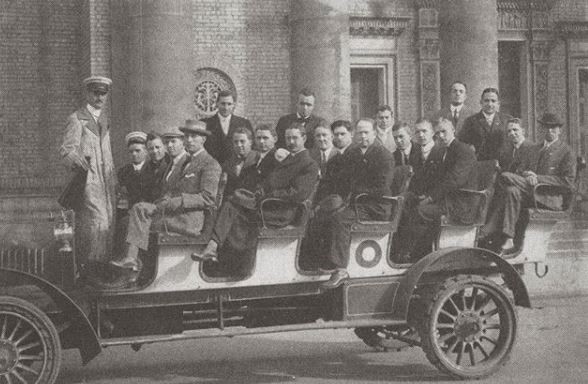Women in Banking and Financial Services – Closing the Gender Gap in Celebration of Women’s International Day
March a.k.a “National Women’s History Month,” is all about celebrating women and their impact throughout history. Not only that, March 8th is celebrated as “International Women’s Day” around the world.
In honor of all the many women who have inspired and paved the way for us all, New England College of Business (NECB) wanted to take this moment to engage with its students, alumni, faculty and staff to candidly discuss women in the workplace, especially when it comes to the banking and financial services industries.
But before we can talk about where we are, let’s take a moment to look back at where we started.
Established in 1909, NECB was originally founded as the “American Institute of Banking” (AIB), by the New England Banking Industry, with the goal of helping working professionals advance in business and financial industries.
Over the past 110 years, it’s an understatement to say NECB has had a longstanding history in the banking and financial services industries when it comes to educating working professionals as well as working with corporate partners to address their workforce needs and challenges.
Below is an AIB class photo. Notice anything interesting? Here’s a hint, there are no women.
And this isn’t a shocking surprise when you consider the year is 1909 and women’s roles were mostly isolated to the home.

Fast forward 110 years to 2019, and thankfully times have improved. Women are on the Supreme Court, CEOs of global corporations, educating our youth, starting new businesses and much more. It’s true, we have made improvements but there is still much more that can be done to address the gender gap, especially when it comes to the banking and financial services industries.
Why, you ask?
According to the World Economic Forum’s 2015 “Global Gender Gap” report, based on the current rate in which women are being hired in the banking and financial services industries, it will take an additional 117 more years before closing the gender gap in terms of labor market opportunity, education, health and political clout.1
But we aren’t willing to wait another 117 years.
Mercer’s global report, “When Women Thrive, Businesses Thrive,” which includes responses from 583 companies across 42 countries including data on 3.2 million employees, serves as the most comprehensive look at women in banking and financial services — making it the largest study of its kind.
The below chart is from Mercer’s study which illustrates the stark contrast in the representation of women versus male employees at all levels in the organization across banking and financial services:

Looking at career level, there is a large opportunity with regards to women representation at the top. Financial services organizations are proportionately promoting more men at every level. Despite efforts by banking and financial services firms to boost female representation by hiring males and females in equal numbers, the current headcount shows men outnumber women 3 to 1 from the managers level to the top. Hence, increasing both groups equally does not address the gender gap issue.
At NECB, we believe closing the gender gap, especially in senior leadership roles, is crucial to properly and fairly represent the ever-growing diversity in the workforce. Echoing this sentiment, Mercer’s key findings highlights the need for companies to be proactive and purposeful with regards to diversifying their workforce because it will ultimately widen the talent pool — enabling companies to innovate and stay competitive.
How can we help close the gender gap?
Everyone has a role to play. Education is a powerful tool that can help open doors to new opportunities.
As a higher education institution that works closely with its banking and financial services partners, NECB believes one of the best places to see change is in the classroom. It’s important to cultivate an environment that encourages women who want to pursue careers in banking and financial services. We are proud to share that NECB’s faculty and staff have predominantly more women than men throughout the College. In fact, 66% of NECB’s full-time faculty are women.

As more and more women have enrolled in college, the demographic of our classrooms has evolved. Within the past decade, NECB has noticed an uptick with the percentage of women pursuing graduate degrees in areas that are relevant to the financial services industry such as Master’s in Business Ethics and Compliance (MBEC), Master of Science in Finance (MSF), and MBA in Finance.
Below is the percentage of women in each of these respective programs at NECB:
- MBA with a Concentration in Finance: 75%
- MBEC, MBA and MBA-Finance: 73%
Part of NECB’s job is to identify new degree program opportunities that jointly support the workforce needs of organizations while addressing the goal of closing the gender gap of women in banking and financial services. To that point, we are excited to share that NECB is launching a Master of Science in Accounting in Fall 2019.
Charla Stetson, current NECB BSBA student with a concentration in Banking/Finance, was just named CEO of Windsor Lock Federal Credit Union where she manages $59 million in assets. Every purposeful action taken to diversify organizations is a step towards eliminating the gender gap.
So, in honor of National Women’s History month and International Women’s Day, we encourage you to look around your organization to see if you notice any of these trends happening and ask yourself, “What role could I play in helping to address this gap?”
1Catalyst. Diversity Matters, Net York: Catalyst, October 1, 2014.
Mercer. (2016). When Women Thrive, Businesses Thrive [pdf]. Retrieved from gl-2016-when-women-thrive-financial-services-perspectives-Mercer.pdf.